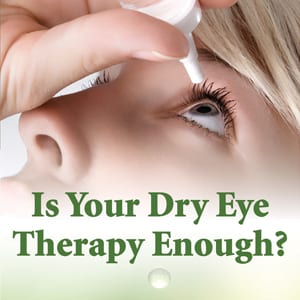 Have you ever felt like your eyes are so dry that you’d like to remove them, soak them in solution, letting them absorb as much moisture as possible, and then put them back in? Or maybe you’ve been in a situation where your vision is distorted (and your box of tissues depleted) because your eyes won’t stop watering. Perhaps it’s a constant itch you can’t scratch? While these irritating sensations seem quite different, they are symptoms of a common, and often treatable, condition called dry eye disease.
Have you ever felt like your eyes are so dry that you’d like to remove them, soak them in solution, letting them absorb as much moisture as possible, and then put them back in? Or maybe you’ve been in a situation where your vision is distorted (and your box of tissues depleted) because your eyes won’t stop watering. Perhaps it’s a constant itch you can’t scratch? While these irritating sensations seem quite different, they are symptoms of a common, and often treatable, condition called dry eye disease.
Neel Desai, MD is a refractive cataract, LASIK and cornea surgeon at The Eye Institute of West Florida, a multi-specialty ophthalmology practice in Tampa Bay that has been providing eye care in the community for 43 years. As a refractive surgeon, Dr. Desai often saw the way dry eye disease (DED) impacted his patients’ outcomes after refractive surgery (a procedure used to reduce or eliminate dependency on glasses, such as cataract surgery or LASIK). The negative effect DED could have on his surgical outcomes drove him to address an unmet need for his patients. To further integrate his treatment approach, he founded The Dry Eye Center of Excellence at The Eye Institute of West Florida.
Dry eye disease is a chronic disease of the ocular surface in which a person doesn’t produce enough quality tears to properly lubricate and nourish the eye. It is estimated that 6.8% of the US adult population (18+) suffer from DED, with prevalence higher among women than men and increasing with age (according to a recent study by the American Journal of Ophthalmology). Effects of DED vary from person to person, with some people not realizing that the symptoms they are experiencing relate to an underlying disease. Common symptoms include irritation, a gritty, scratchy or burning sensation, a feeling of something in your eye(s), excess watering and blurred vision.
The symptoms of DED can range from mild to severe, and because of this, patient’s often find that their symptoms have gone undiagnosed and they are constantly searching for relief. Improper treatment of DED can also result in visual problems after refractive surgery.
of Dr. Desai explains that, “We understand that DED can affect a number of things related to a patient’s vision, often making it look like there’s a refractive error that really isn’t there. This can have a negative effect on the refractive outcome post-surgery, which is something we need to take into consideration. We want to identify and treat DED before surgery to give patients the best chance at a positive visual outcome.”
Pre-operative testing is performed to identify the health of the patient’s eye before undergoing surgery. If symptoms of DED are detected, the patient is referred to The Eye Institute’s Dry Eye Center of Excellence to address and properly treat their DED.
Tina Crevello, PA-C first meets with patients with signs of DED to perform further diagnostic testing and begin formulating a treatment plan. She notes that many of the patients referred to her have had symptoms of DED for years, often stating that they have gone to providers looking for treatment options to no avail. The Dry Eye Center of Excellence understands the impact DED can have on ever day life and approaches each patient with this level of empathy.
“We want to convey, ‘I understand the symptoms that you’re having, and we’re going to try to figure out why,’” Dr. Desai adds. “‘You’re not crazy for feeling this way; you’re not crazy for noticing fluctuating vision or having visual complaints. We totally understand, and we can help.’”
Each team member is trained to understand the importance of listening to the patient’s visual concerns, educating each patient on what exactly is happening with their eyes and why and providing a solution to the problem.
Robert Weinstock, MD, Director of Cataract and Refractive Services at The Eye Institute of West Florida emphasizes the importance of providing patient education for each patient to ensure a deeper understanding DED. “Our website contains information on The Dry Eye Center of Excellence and, once in the practice, a dry eye disease pamphlet, created by Dr. Desai, is available for patients, which highlights the forms of DED and its symptoms,” he notes.
“It’s very important for us to inform patients of what to expect with any type of eye disease. When it comes to DED, treatment is a process. It’s not a disease that goes away overnight, and we need to inform our patients of this before they begin a treatment plan,” Dr. Weinstock explains.
Dr. Desai adds, “Depending on the severity and the underlying cause, we have different levels of treatment. There are a number of variables that go into each stage of treatment, and it really is a case by case situation, but we are happy to have an expert available for every step of the process.”
While dry eye disease may not be a new concern, The Eye Institute of West Florida is revolutionizing the approach for treating it with The Dry Eye Center of Excellence.

